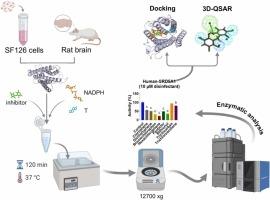卤化消毒剂作为5α-还原酶1型抑制剂的构效关系:对神经类固醇合成的潜在影响
IF 11.3
1区 环境科学与生态学
Q1 ENGINEERING, ENVIRONMENTAL
引用次数: 0
摘要
神经甾体调节神经功能,其合成依赖于5α- 1型还原酶(SRD5A1)。SRD5A1的失调与神经精神疾病有关。卤化消毒剂是广泛使用的抗菌化合物,可能通过抑制SRD5A1来调节神经甾体生成。本研究评价了8种卤代消毒剂对人和大鼠SRD5A1活性的影响,并对其构效关系进行了表征。使用人SF126细胞微粒体和大鼠脑微粒体,所有被测化合物均显著抑制SRD5A1活性。六氯苯效价最高(IC50 = 5.50 μM),其次为溴氯苯(7.10 μM)、比硫醇(7.33 μM)、苯氯酚(14.57 μM)、二氯苯(18.34 μM)和氯苯(25.51 μM)。酶动力学分析揭示了混合/非竞争性抑制机制。与人类SRD5A1相比,大鼠SRD5A1的敏感性降低。在完整的细胞中,所有化合物都以浓度依赖的方式显著减少双氢睾酮的产生。分子对接显示与NADPH位点结合,结合能与效价相关。3D-QSAR模型确定了氢键受体和疏水特征是抑制的关键。结构活性分析揭示了其效价与LogP、分子量和卤素含量等理化性质之间的相关性。利用k组分析框架中的算术残差进行的跨物种相关性评估提供了增强的分析验证,并确认了物种特异性活性模式,高活性化合物在两个物种中一致聚类。这些发现表明,卤化消毒剂是有效的SRD5A1抑制剂,对神经类固醇生物合成和神经精神健康具有潜在影响,为环境风险评估和治疗应用提供了结构见解。本文章由计算机程序翻译,如有差异,请以英文原文为准。

Structure-activity relationships of halogenated disinfectants as potent inhibitors of 5α-reductase type 1: potential impact on neurosteroid synthesis
Neurosteroids modulate neural function, with their synthesis dependent on 5α-reductase type 1 (SRD5A1). Dysregulation of SRD5A1 has been implicated in neuropsychiatric disorders. Halogenated disinfectants, widely used antimicrobial compounds, may modulate neurosteroidogenesis through SRD5A1 inhibition. This study evaluated the effects of eight halogenated disinfectants on human and rat SRD5A1 activity and characterized their structure-activity relationships. Using human SF126 cell microsomes and rat brain microsomes, all tested compounds significantly inhibited SRD5A1 activity. Hexachlorophene showed the highest potency (IC50 = 5.50 μM), followed by bromochlorophene (7.10 μM), bithionol (7.33 μM), fenticlor (14.57 μM), dichlorophene (18.34 μM), and clorophene (25.51 μM). Enzyme kinetic analyses revealed mixed/noncompetitive inhibition mechanisms. Rat SRD5A1 showed reduced sensitivity compared to human SRD5A1. In intact cells, all compounds significantly reduced dihydrotestosterone production in a concentration-dependent manner. Molecular docking showed binding to the NADPH site, with binding energies correlating with potency. 3D-QSAR modeling identified hydrogen bond acceptor and hydrophobic features as critical for inhibition. Structure-activity analyses revealed correlations between potency and physicochemical properties including LogP, molecular weight, and halogen content. Cross-species correlation assessment using the arithmetic residuals in K-groups analysis framework provided enhanced analytical validation and confirmed species-specific activity patterns with high-activity compounds clustering consistently across both species. These findings demonstrate that halogenated disinfectants are potent SRD5A1 inhibitors with potential implications for neurosteroid biosynthesis and neuropsychiatric health, providing structural insights for both environmental risk assessment and therapeutic applications.
求助全文
通过发布文献求助,成功后即可免费获取论文全文。
去求助
来源期刊

Journal of Hazardous Materials
工程技术-工程:环境
CiteScore
25.40
自引率
5.90%
发文量
3059
审稿时长
58 days
期刊介绍:
The Journal of Hazardous Materials serves as a global platform for promoting cutting-edge research in the field of Environmental Science and Engineering. Our publication features a wide range of articles, including full-length research papers, review articles, and perspectives, with the aim of enhancing our understanding of the dangers and risks associated with various materials concerning public health and the environment. It is important to note that the term "environmental contaminants" refers specifically to substances that pose hazardous effects through contamination, while excluding those that do not have such impacts on the environment or human health. Moreover, we emphasize the distinction between wastes and hazardous materials in order to provide further clarity on the scope of the journal. We have a keen interest in exploring specific compounds and microbial agents that have adverse effects on the environment.
 求助内容:
求助内容: 应助结果提醒方式:
应助结果提醒方式:


